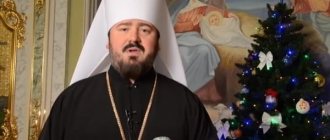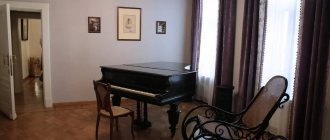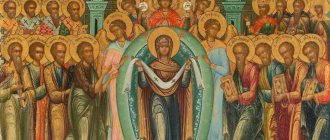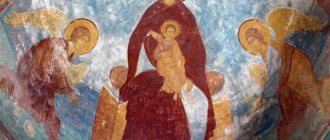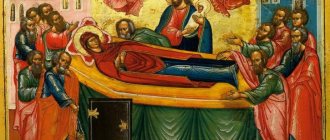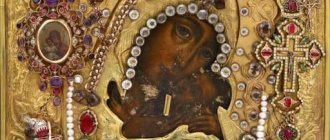My cousin could not conceive a child, although the tests were good. I visited so many doctors, but to no avail. One believing woman advised her to pray to the Mother of God for the gift of a baby, and for this she needed an icon of the Annunciation.
A year later, my sister told me the good news that she was having a baby. In the article I will tell you about the feast of the Annunciation, about the gospel story of the Archangel’s visit to the Virgin Mary, and about how the Annunciation icon helps believers.
Good News of the Blessed Virgin Mary
Annunciation of the Blessed Virgin Mary Dates: XVIII century. Material: Wood, pavolok, gesso, tempera Icon dimensions: height 86 cm, width 69.5 cm Storage: Kargapol State Historical, Architectural and Art Museum
The Gospel says little about the Annunciation, and only the apostle talks about it in detail. Luke:
“...The angel Gabriel was sent from God to the city of Galilee, called Nazareth, to a virgin betrothed to a husband named Joseph, from the house of David; The name of the Virgin is: Mary. The angel, coming to Her, said: Rejoice, full of grace! The Lord is with You; Blessed are You among women. She, seeing him, was embarrassed by his words and wondered what kind of greeting this would be. And the Angel said to Her: “Do not be afraid, Mary, for You have found grace from God; and behold, you will conceive in your womb and give birth to a Son, and you will call His name Jesus. He will be great and will be called the Son of the Most High, and the Lord God will give Him the throne of His father David; and He will reign over the house of Jacob forever, and His kingdom will have no end.” Mary said to the Angel: “How will this be when I don’t know my husband?” The angel answered Her: “The Holy Spirit will come upon You, and the power of the Most High will overshadow You; therefore the Holy One who is to be born will be called the Son of God...” Then Mary said: “Behold, the Servant of the Lord; let it be done to me according to your word” (Luke 1:26-38).
Annunciation with Unicorn (1480–1500)
Schlossmuseum, Weimar
Medieval bestiaries told about many fantastic beasts and attributed amazing traits to real animals. Theologians have found parallels between the descriptions of some animals and events from the life of Jesus: for example, the sacrifice, Eucharist and resurrection were symbolized by a pelican feeding its chicks with its own blood, and a lion, which was born dead and came to life on the third day from the breath of a lioness. Another symbol of Christ was the unicorn, which only an immaculate virgin could catch. In the 15th–16th centuries, the plot of hunting a unicorn became popular, especially in Germany. Corresponding illustrations appear in manuscripts and engravings, on altars, tapestries and tableware.
Mary, depicted on the wing of the altar, sits in the garden. Gabriel drives the unicorn towards her. The Archangel is accompanied by four dogs, symbolizing the virtues: truth, mercy, peace and justice. Images of the hunt for a unicorn often turned into a naive enumeration of what symbolizes the Virgin Mary: a locked garden, an enclosed well A locked garden and an enclosed well are images of the bride from the Song of Songs, who in the Middle Ages was considered a prototype of Mary., the burning bush The burning bush is a bush on the mountain Sinai, from which God spoke to Moses. The burning but not burnt bush symbolized the purity of Mary., Gideon's fleece According to the Old Testament, Gideon, one of the judges of Israel, was convinced that the Lord had chosen him when the fleece he left overnight remained dry the next morning, although the whole earth around it was wet from dew, and the next morning, on the contrary, it lay wet on dry ground., closed gates The closed gates are an image from the vision of the prophet Ezekiel, also considered an anticipation of the Annunciation. The Lord had to pass through these gates. and Aaron's rod Aaron's rod miraculously blossomed overnight - in this story they saw an allusion to the birth of the Savior from a virgin.. The secular nature of the scene aroused the discontent of the church, and in 1545 at the Council of Trent such images were prohibited.
Iconography
The first images of the Annunciation are already in the Roman catacombs of the 2nd-4th centuries.
Useful materials
However, according to N.V. Pokrovsky, the theme of the Annunciation, as well as the veneration of the Mother of God in general, then had less significance for believers than Christ Himself and His teaching, so the event of the Annunciation appears infrequently.
The plot became widespread from the 4th century, when, with the spread of heresies, disputes about the veneration of the Mother of God also began (for example, the heretic Nestorius, who considered Christ a simple man, rebelled against the name “Theotokos”).
Apparently, the controversy surrounding Nestorianism contributed to the strengthening of veneration of the Mother of God. Obviously, it was in the 4th century. The church-wide holiday of the Annunciation, “our main salvation,” also appears.
Annunciation of the Blessed Virgin Mary, Akathist to the Mother of God Dates: XVI century. First half of the 16th century. Origin: From the Transfiguration Cathedral of the Spassky Monastery in Yaroslavl. Material: Double ark, pavoloka, gesso, tempera Dimensions of the icon: height 120 cm, width 92 cm In the middle of the icon there is the composition 'Annunciation with a spinning maiden' - one of the variants of the Annunciation with needlework. The order in which the side marks are read is unconventional (from right to left).
The iconography of the Annunciation does not always correspond to the canonical story of the Apostle Luke.
Then among Christians, along with the Gospels, which later (not earlier than the end of the 4th century) were recognized by the Church as canonical (these are the now famous four Gospels), there were also other texts in circulation telling about the same Gospel events, many of which were not later included to canon .
However, the plots of these apocrypha remained in ancient iconography. These are the “Proto-Gospel of James”, “The Book of the Nativity of the Blessed Mary and the Childhood of the Savior” and others.
According to these legends, the first meeting of Mary and Archangel Gabriel took place at a spring or well. Therefore, on many ancient icons the event is depicted this way.
Other apocrypha tell that Gabriel appeared to Mary twice - at the source, where she heard a voice, but saw no one, and in the house where she was sitting at the spinning wheel.
Interesting fact
According to the Proto-Gospel of James, Mary was making a curtain for the temple in Jerusalem - one that would later, at the moment of the death of Her Son, be torn in two. Therefore, Virgo can be depicted at a spinning wheel or with a skein of yarn.
Tinos Icon of the Annunciation of the Blessed Virgin Mary
The same story dates back to what was quite common in the 13th-14th centuries. the image on the icon of a girl (“maidservant”), because, according to the text of the apocrypha, the priests gave the task of making the veil to other virgins, in total eight, besides Mary.
The color of the yarn has a symbolic meaning - red, the color of royal dignity, which simultaneously refers to both the Virgin and Her Son.
Finally, Mary is often depicted reading in the book the prophetic words “Behold, the Virgin is with child and will bear a Son...”. This version of the circumstances of the event was also in circulation among believers in the first centuries of Christianity.
Icon of the Annunciation of the Blessed Virgin Mary
the conversation between the Virgin and Archangel Gabriel, was also reflected in the iconography . Luka. In icons it is expressed in sign language.
The hand of the Archangel extended to Mary is a gesture of an ancient orator, understandable to the then inhabitant of the Roman Empire.
The Virgin’s palm turned to the Archangel in a gesture of submission directly correlates with Her words “Behold the handmaid of the Lord...”, and the palm turned towards the viewer (gesture of denial) - with Her perplexed question: “How will this be when I don’t know my husband?” .
In addition, on various icons of the Annunciation, the Mother of God can be depicted both sitting and standing, because it was standing that was then customary to listen to the will of the king of the earth.
Mary also meets the messenger of the King of Heaven. When the Mother of God is depicted seated, she often sits on a decorated likeness of a throne, which already marks Her dignity as the Mother of the Messiah.
The variety of details and details of the image gave the icon painter the opportunity to present his vision of the great event of the Annunciation, placing emphasis accordingly.
That is why the icons of the Annunciation not only reflect church tradition. They themselves also often become the subject of theological interpretation, especially if, according to Fr. Pavel Florensky, “are painted from life,” that is, they are a reflection of the spiritual experience of the icon painter.
Piero della Francesca. "Annunciation" (1452–1466)
1 / 2
Piero della Francesca. Annunciation Basilica di San Francesco, Arezzo / Wikimedia Commons
2 / 2
Piero della Francesca. The lowering of Judas Cyriacus into the well of the Basilica di San Francesco, Arezzo / Wikimedia Commons
The Annunciation could be an independent plot, or part of a cycle dedicated to the Mother of God, or the first scene in the depiction of the life of Christ. In Piero della Francesca, the Annunciation unexpectedly becomes part of the story of the discovery of the cross on which Jesus was crucified. Mary and the angel are placed in a classical architectural space (in Renaissance painting it replaces the conventional images of buildings of Gothic and Byzantine art). The tiers of the building divide the composition into two registers: the earthly one, in which the angel addresses Mary, and the heavenly one, with the image of God the Father.
The laconic composition is almost devoid of details, so the rope hanging from the beam by the window attracts attention. On the one hand, this symbol recalls the instruments of the passion. The instruments of the passion are the instruments of the martyrdom of Jesus Christ., on the other hand, with the help of this image, della Francesca connects the Annunciation with the scene of the torture of Judas Cyriacus, which is depicted in the upper case. According to apocryphal legend, in the 4th century, the Roman Empress Helen, mother of Constantine the Great, who made Christianity the state religion of the Roman Empire, initiated excavations in Jerusalem to find the cross on which Jesus was crucified. The Jews refused to help Helen in her search, and then she ordered one of them, Judas, to be put in a dried up well. A few days later, Judas began to beg for his release and promised to help him find the cross. Rescued from the well, he prayed to God - and saw the place where the cross was: so he believed in Christ. However, the devil appeared to him and accused him of betraying him, unlike Judas Iscariot. The rope on the beam reminds us of Iscariot and the rope with which he hanged himself. The empty loop, which was of no use to the believing and saved Judas Cyriacus, indicates the salvation that follows the coming of Jesus into the world.
Famous images
Icon of the Annunciation of the Blessed Virgin Mary. Icon painter: Andrey Rublev. Kept in the State Tretyakov Gallery, it dates back to 1405.
Image of the Mother of God by Andrei Rublev
Sometimes the icon painter manages to depict confusion and submission to the will of God at the same time .
This is the icon of the Annunciation by Andrei Rublev - the left hand of the Mother of God is pressed to her chest, while the right hand is extended to the Angel, signifying the acceptance of the will of the Lord.
The icon was part of the iconostasis of the Annunciation Cathedral of the Moscow Kremlin, and is now kept in the State Tretyakov Gallery. Art critics pay attention to the image of Gabriel, to the fact that St. Andrei Rublev managed to show his dynamism and mobility. deep meaning.
Tinosskaya
30
January
1823
On the Greek island of Tinos, an icon was found, also called by the Greeks “Great Joy”.
It is believed to date back to the 1st century AD, so it may have been written by the Evangelist Luke himself. If so, this is the first known icon of the Annunciation. The island of Tinos is now a place of pilgrimage for pious Greeks. Here, through the efforts of the established charitable Society of the Annunciation, a temple was built, under which there is a consecrated spring.
Kyiv
Kyiv Icon of the Annunciation of the Blessed Virgin Mary
The Kiev Icon of the Annunciation is a mosaic, one of the most ancient in Rus', located on the pillars of St. Sophia Cathedral, dating back to 1040. Here, as in the most ancient Byzantine images, Mary is represented spinning a purple thread. This version of the icon does not include any details , presenting only the figures of the Archangel and Mary.
"Ustyug drawing"
Another image of the Annunciation is equally laconic - Ustyug. Its peculiarity is that, in addition to Mary and the Archangel, it depicts the Son of God in the womb of the Mother. At the top of the icon there is an image of God the Father, the Old Denmi, which is also rare.
Moscow
The Moscow Icon of the Annunciation was, according to surviving descriptions, depicted on the wall, using oil paints on plaster. For a long time, the icon was one of the main Moscow shrines, but has not survived to this day (the church with the icon was destroyed in 1932).
Mosaic on the triumphal arch at Santa Maria Maggiore (5th century)
© Diomedia
At the turn of the 420-430s, the Archbishop of Constantinople Nestorius taught that “only flesh can be born of the flesh” and the Son of Mary is only a man in whom the Word of God is embodied, but not God himself. In 431, the Third Ecumenical Council was held in Ephesus, declaring that Mary was the Mother of God and declaring the teachings of Nestorius to be heresy. Mary was revered before, but her cult became especially strong after the resolution of the council. Next year, work begins in Rome on the mosaics of Santa Maria Maggiore, one of the first city basilicas dedicated to the Virgin Mary. The Annunciation scene adorns the triumphal arch, and it was important for its authors to show the greatness of Mary. The Virgin is dressed like a noble girl, wears a tiara, earrings and a necklace, and is surrounded by a retinue of angels. The spindle she holds in her hands hints at Mary’s chosenness. The apocryphal Proto-Gospel of James, written in the 2nd century, says that seven girls from the line of King David (it was among his descendants that the Messiah would appear) were chosen to work on the veil of the Temple. Among them was Maria. To decide who should spin what, lots were cast. Mary received purple and crimson - the most valuable fabrics. She took her work home, where the Archangel Gabriel appeared to her.
Cases of miraculous help
Many icons of the Annunciation have proven themselves to be miraculous. In this case, the appearance of the image itself is often a miracle.
For example, the discovery of the Tinos Icon is associated with the repeated personal appeals of the Mother of God to the nun Pelagia: the Most Holy One encouraged Pelagia to search for Her image.
During the developing onslaught of godlessness, Pelagia was subjected to ridicule and persecution, they said that she was “in delusion,” however, the search continued. Finally, the icon was found. Its colors, according to eyewitnesses, have not faded at all, although the image apparently lay in the ground for about 800 years.
In 1290, Procopius of Ustyug, known for his feat of foolishness, prayed before the Ustyug Icon of the Annunciation, and then all the inhabitants of the city, and through the intercession of the Blessed Virgin, God’s wrath was averted from Ustyug in the form of a “stone-fire” cloud.
Annunciation of the Blessed Virgin Mary Dates: XII century. 30-40s of the 12th century Icon painting school or art center: Novgorod school Origin: From the St. George Cathedral of the Yuriev Monastery in Novgorod, from where it was brought, among other icons, by Ivan the Terrible to the Assumption Cathedral of the Moscow Kremlin. Material: Wood, tempera Dimensions of the icon: height 238 cm, width 168 cm State Tretyakov Gallery, Moscow Literature: State Tretyakov Gallery. Collection catalogue. Old Russian art of the 10th - early 15th centuries. Volume I. No. 7.
The Moscow icon is one of those not made by hands . She appeared on the prison wall to the boyar who was unjustly arrested by Tsar Ivan IV. The king learned about the phenomenon and pardoned the condemned man. A church was built on the site of the prison, and a rich frame was subsequently made for the icon.
Deesis
Deesis is from the Greek word δέησις, meaning “prayer, petition.” The composition of such an icon, as a rule, embodies the idea of the intercession of saints for people before Christ. In the center of the composition is depicted the Savior Almighty (Christ), on the sides facing Him are the Mother of God and John the Baptist, the Archangels Michael and Gabriel, the Apostles Peter and Paul and other saints. The figures are arranged in a strictly defined order. There are main Deesis (image of only heads), shoulder-length, waist-length and full-length.
Deesis icons, in most cases consisting of three figures, were located above the royal doors of the altar barriers in the 12th–14th centuries. In addition, deesis were placed above the entrance doors and gates of church and civil buildings. Deesis compositions were often depicted on the upper margins of icons and were part of complex compositions, such as, for example, “The Last Judgment.”
The icon, kept in the Tretyakov Gallery, depicts the Savior Emmanuel - Christ in adolescence. On the sides are the Archangels Gabriel and Michael, bowing their heads towards Him on both sides. The light brown ocher swirl has been greatly lost. Sankiri is different: Archangel Michael’s is a dark greenish ocher, Spas’s is dark, Archangel Gabriel’s is green.
The clothes are made with a dense layer of colors. Archangel Michael has a pinkish-lilac chiton and a dark blue himation. Emmanuel's chiton is ocher, with a golden assist. Archangel Gabriel has a blue chiton and a pinkish-lilac himation. The Archangels have blue toroki in their hair with red stones set in gold. Fragments of pink halos have been preserved along the contours of the heads; the golden background has survived above the shoulders of the Archangels. In the background there are inserts of new gesso at different times, below there is a finishing touch from the 18th century. The icon is made on a linden board, the dowels are vertical, driven from bottom to top. Size 72 x 129 cm.
In the left corner on the field there is a red wax seal of the Great Assumption Cathedral. The image comes from the Assumption Cathedral of the Moscow Kremlin, where it was located above the northern doors of the iconostasis. Disclosed by I. A. Baranov in 1936.
In preparing the material, we used the Collection of Old Russian Painting of the State Tretyakov Gallery, ed. Antonova V.I. and Mneva N.E.
***
The miraculous icon of the Annunciation helps both those personally praying and those asking for loved ones
There are many revelations of miraculous healing from infertility, both male and female. Faith and prayers to the image of the Annunciation brought joy in the form of replenishment, even in cases where medicine remained powerless.
The icon of the Annunciation helps those praying for diseases of the soul and body, asking for deliverance from drugs, alcohol and other addictions. Makes it easier for people in prison. Protects from sins and forgives those who have sinned. Guides you on the right path in times of mental turmoil.

